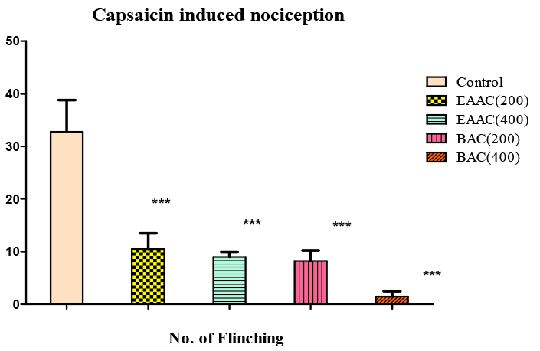Print version
Search Pub Med
Amelioration of chronic pain by Anthocephalus chinensis extract is mediated through TRPV1 receptors Recent studies pointed the use of flavonoids and their analogues as TRPV1 antagonist without causing hyperthermia, directing the research for the development of flavonoids as TRPV1 antagonists (1). In an attempt towards this direction, flavonoid rich extract of Anthocephalous chinensis (Family: Rubiaceae) of traditional medicine claimed to be useful to treat pain disorders but lacks scientific evidence has been selected to explore efficacy in chronic pain model. Chronic pain was induced by partial sciatic nerve ligation (PSNL) and experimental protocol was approved by the Institutional Animal Ethics Committee (IAEC) (1548/Po/a/11/NIP/10.2013/PC/67). The effect of ethyl acetate (EAAC) and butanolic (BAC) extracts of A. chinensis prepared by using standard protocols was assessed on behavioral parameters like mechanical hyperalgesia, thermal hyperalgesia, allodynia and biochemical parameters like calcium ATPase assay at two different doses 200 and 400 mg/kg. In order to verify activity of EAAC and BAC on TRPV1 receptor, capsaicin induced nociception and immunohistochemistry of dorsal root ganglia were performed (2, 3). The data was presented as mean ± SEM and analysed by two-factor ANOVA and one-factor ANOVA as required followed by post hoc analysis using Bonferroni test. The yield of flavonoid rich extract EAAC and BAC was 2% w/w and 3.9% w/w respectively. HPTLC fingerprinting showed that EAAC contains more number of flavonoids while quantification shows more concentration of flavonoids in BAC. Both the extracts have significantly reduced mechanical hyperalgesia, thermal hyperalgesia and allodynia as shown in the given table. A marked decrease in capsaicin induced number of flinches and liking in EAAC (9.2±0.85; 0.5±0.02 at low dose and 8.2±0.91; 0.8±0.01at high dose) and BAC (8.7±0.56; 1.5±0.04 at low dose and 1.2±0.08; 0 at high dose) treated groups when compared to control (32±6.2; 2.4±0.28) rescpectively, suggests activity of extract on TRPV1 which was supported by immunohistochemistry of sciatic nerve. Neither EAAC nor BAC has shown any change in body temperature pointing the advantage of EAAC and BAC as probable TRPV1 antagonists. In summary, the observations of present study suggest that EAAC and BAC have shown marked reduction in chronic pain without affecting body temperature. The study also hints that EAAC and BAC may act on TRPV1 but confirmation should be carried out by further detailed electrophysiological studies.
|



